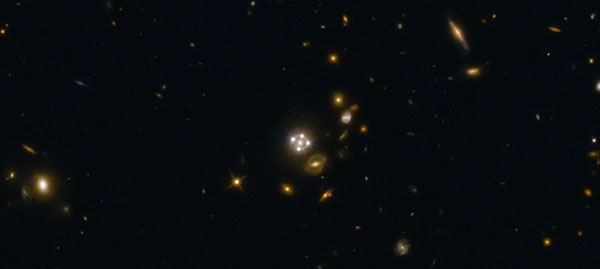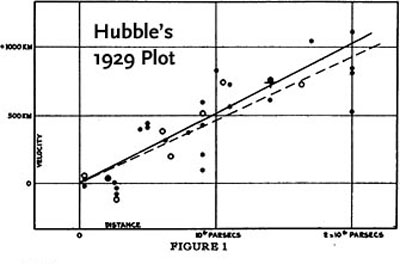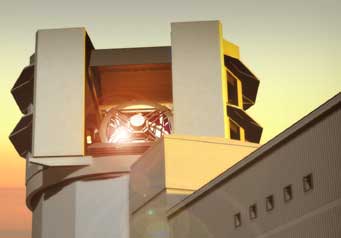New observations of quasars might contradict results derived from the cosmic microwave background, suggesting the universe’s expansion could be accelerating more than we thought.
A new study of three flickering quasars magnified via cosmic lenses says that the universe might be expanding even faster than some cosmologists thought. The result gainsays incredibly precise numbers derived from observations of the cosmic microwave background (CMB).
The key words in the first sentence, though, are “might be.” The result doesn’t conflict with all measurements of the rate of cosmic expansion, and the apparent contradiction isn’t causing astronomers to lose sleep just yet. Here’s why.

ESA / Hubble / NASA / Suyu et al.
The Inconstancy of the Hubble Constant

E. Hubble / D. Block / H. Duerbeck
When Edwin Hubble examined the velocities of nearby galaxies almost a century ago, he found they were all drifting away from the Milky Way — and the farther they were, the faster they appeared to be moving. He measured the current rate of recession, now known as the Hubble constant (though the credit belongs to others too), in kilometers per second per megaparsec. (A megaparsec is a million parsecs, and a parsec is 3.26 light-years.)
Initial measurements of the Hubble constant were pretty imprecise, but towards the last half of the 20th century, they became good enough that two teams hotly debated its value. One side argued for a Hubble constant closer to 100 km/s/Mpc, while the other side said it ought to be closer to 50 km/s/Mpc.
The matter was partially resolved with the help of new observations from the Wilkinson Microwave Anisotropy Probe (WMAP) and the Hubble Space Telescope. The two spacecraft observed the universe from opposite ends of cosmic time. WMAP mapped the Big Bang’s afterglow, a radio hiss heard from every direction of the universe. The temperature fluctuations in this cosmic microwave background reveal minute density variations in the very young universe when it was just 380,000 years old.
Meanwhile, Hubble monitored the steady blinking of Cepheid variable stars in nearby galaxies; These stars’ periods are directly linked to their brightnesses, and astronomers observing these standard candles can calculate galactic distances and thus the Hubble constant.
By the turn of the 21st century, the dust seemed to have cleared: the WMAP and Hubble teams had both settled on values near 70 km/s/Mpc.
Yet as astronomers continued to beat down the range of uncertainty on the constant’s exact value, using new data from Hubble and Planck (WMAP’s successor), the gap began to widen again. Recently revised Planck measurements gave a Hubble constant of 67.8+/-0.9, while recent Hubble observations of Cepheid variables resulted in a value of 73.2+/-1.7 km/sec/Mpc. There’s only a 0.3% chance that this difference could be a statistical fluke — though that doesn’t mean that astronomers aren’t missing some effect that’s systematically offsetting the observations. It seems only more and better data will resolve the matter — déjà vu all over again.
H0Li COW: A New Perspective
Lots of celestial objects have found themselves part of the quest to measure the Hubble constant: Cepheid stars, supernovae, galaxy clusters, and the cosmic microwave background, to name a few. Now quasars have entered the fray.
They’re pretty ordinary as quasars go, but they happen to sit behind massive galaxies when viewed from Earth. Each galaxy’s gravity acts as a cosmic lens, bending the light from the background quasar and splitting the light into four images, a formation known as Einstein’s Cross.
This being real life, things aren’t lined up exactly perfectly, so the four paths taken by a quasar’s light aren’t identical. Not only that, but they take different paths through the lensing galaxy, so some paths encounter more stuff along the way. The effect is similar to four friends driving along separate routes to get from Boston to New York. Even if they leave at the same time, they may arrive at different times depending on how long their route is and how much traffic they encounter.
You’d never notice the difference in arrival times if the light were constant, but flickering is one of quasars’ defining characteristics. As long as astronomers understand the galaxy-shaped lens that the light is passing through, all they have to do is measure the time delay between the four flickering images and they'll have an independent measure of all the distances in the system, independent of the quasar's or lensing galaxy's redshift. From that, they can calculate the Hubble constant.
Imaging gravitational lenses such as these is the goal of a large, international collaboration known as the Cosmological Monitoring of Gravitational Lenses (COSMOGRAIL) and especially the subgroup dubbed H0 Lenses in COSMOGRAIL’s Wellspring (H0Li COW). (As in, holy cow, just spelling out those acronyms took a whole paragraph!)

ESA / Hubble / NASA / Suyu et al.
So far, the group has analyzed three of five lensed quasars. In a paper published in the Monthly Notices of the Royal Astronomical Society, Vivien Bonvin (Federal Polytechnic School of Lausanne, Switzerland) and colleagues announced a new determination of the Hubble constant, between 68.9 and 74.3.
There’s too much wiggle room to say yet if this outright disagrees with the Planck result. (In technical terms, the statistical significance of the difference is 2 sigma, or 98.7%, which isn’t enough to by itself convince scientists). Still, it’s more in line with the results based on nearby Cepheids. The lensing result also extends an ongoing trend: the Hubble constant derived from the objects in the “mature” universe is consistently higher than the Hubble constant calculated from measurements of the younger universe as seen in the cosmic microwave background (the three points on the left in the plot below).

Ana Aceves
Making Sense of Discrepancy
So what does the astronomy community think about the discrepancy? After all, a real difference could point to a need for new physics, some change to our theory of cosmology that affects the beginning of the universe in a different way than the one we live in. But there’s still a possibility that the difference isn’t real at all. Mixed feelings reign.
“Now that our technique is becoming precise enough to play a significant role in that context, the idea that solving the tension might need a real change in our understanding of physics is becoming more and more popular,” Bonvin says.
But not everyone agrees.
“This does not keep me up at night,” says Ned Wright (UCLA), who was not involved in the H0Li COW study. “Two-sigma differences [that is, differences that have a 5% chance of occurring by statistical chance] happen quite often, so you are wasting your time by chasing them.”
Bonvin agrees that the H0Li COW results by themselves aren’t strong enough to make any claims — they don’t keep him up at night either. Still, he argues, “things start to become really interesting when we consider all three experiments altogether.”
Since the quasar lensing technique is completely independent from the Cepheid standard candles, the two values can be averaged and compared with the Hubble constant measured from Planck data. When you do that, Bonvin says, the difference becomes more interesting (with a statistical significance of 3.9 sigma, for those keeping track).

The team is still analyzing two more quasar lenses and will achieve tighter precision with those results in hand by early 2018. Moreover, with the advent of the Large Synoptic Survey Telescope (LSST) and other sky surveys, the discovery and monitoring of additional quasar lenses will enable astronomers to cut the statistical wiggle room in half. Gaia and JWST will also prove crucial to precisely measuring the distance to farther Cepheids.
New physics may yet help resolve the tension in Hubble constant measurements, but ultimately, the key to settling the difference still comes down to finding more and better data.
 6
6









Comments
David-Wickholm
February 2, 2017 at 5:25 pm
The article states, "As long as astronomers understand the lensing galaxy, all they have to do is measure the time delay between the four flickering images and they can calculate the Hubble constant." Could you explain just how that works? It is not obvious to this casual reader. A reference that I could look up wpuld be great. Thanks Monica.
You must be logged in to post a comment.
Monica YoungPost Author
February 3, 2017 at 4:28 pm
Sure, here's a relatively approachable explanation: http://www.jb.man.ac.uk/distance/frontiers/glens/section5.htm. Basically, the time delay gives you a measure of distance that's independent of the object's redshift, so you can measure the object's velocity and distance, which gives the Hubble constant. (I've modified the text a bit to clarify this.)
You must be logged in to post a comment.
Lindsay
February 3, 2017 at 10:22 pm
If the expansion of the Universe is accelerating (is that still the consensus?), could that skew any of these different methods of measurement?
You must be logged in to post a comment.
Curty
February 7, 2017 at 2:11 am
This article reinforces an idea I had many years ago after reading an author's quip asking "maybe photons lose energy over time, and that explains the red shirt".
I took it one step further and thought that photons lose energy as they plow through gas, dust, neutrinos and dark matter for millions or billions of years. And the random distribution of gas and dust explains why this red shift varies so much, and is so hard to pin down.
Then at Quora.com someone asked about energy conservation and dark energy, and I suggested that maybe the expansion of the Universe is powered by photons as they are red shifted over time. This might explain why the early Universe didn't expand as rapidly as the mature Universe: less light
So, have any math-intensive astronomers formulated some equations to support any of these three ideas?
Thanks,
Curt
You must be logged in to post a comment.
John
February 9, 2017 at 9:31 am
"...gainsays..." ??? Now there's a word I haven't seen in print since the 19th century authors! Well done!
You must be logged in to post a comment.
Margarita
February 28, 2017 at 11:22 am
Readers might like this link to the ESA Hubble Space Telescope science release which has links to downloadable copies of all the MNRAS papers by Sherry Suyu's team (which includes Vivien Bonvin)
http://www.spacetelescope.org/news/heic1702/
heic1702 — Science Release
"Cosmic lenses support finding on faster than expected expansion of the Universe"
26 January 2017
It also has a link to this helpful Hubblecast on YouTube about gravitational lensing
https://youtu.be/8QL4gzgtosc
You must be logged in to post a comment.
You must be logged in to post a comment.